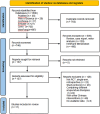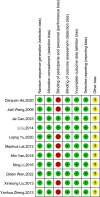Comparative effects of acupuncture and metformin on insulin sensitivity in women with polycystic ovary syndrome: a systematic review and meta-analysis
- PMID: 40607225
- PMCID: PMC12213467
- DOI: 10.3389/fendo.2025.1553684
Comparative effects of acupuncture and metformin on insulin sensitivity in women with polycystic ovary syndrome: a systematic review and meta-analysis
Abstract
Objective: To systematically evaluate the clinical efficacy of acupuncture and metformin on insulin resistance (IR) in women with Polycystic Ovary Syndrome (PCOS).
Methods: A computer search was conducted up to September 30, 2024, in databases including PubMed, EMBASE, Cochrane Library, China Biology Medicine disc (CBM), China National Knowledge Infrastructure (CNKI), Wanfang, and VIP, to collect randomized controlled trials (RCTs) on acupuncture treatment for PCOS. The effect of acupuncture and metformin on insulin sensitivity in PCOS patients was assessed. Two researchers independently screened the literature, extracted data, and evaluated the quality of included studies using the bias assessment tool recommended in the Cochrane Handbook for Systematic Reviews of Interventions 5.1.0. Meta-analysis and network analysis were conducted using Stata 17.Our primary outcome measure was the homeostasis model assessment of insulin resistance(HOMA-IR).The secondary outcomes were fasting blood glucose (FBG), fasting insulin (FINS), body mass index (BMI), and waist-to-hip ratio (WHR).
Results: A total of 11 RCTs involving 1,248 patients were included. The meta-analysis results showed that the reduction in HOMA-IR [SMD = 0.17, 95% CI (-0.18, 0.52)] and FINS [SMD = 0.17, 95% CI (-0.38, 0.71)] values in the acupuncture group were smaller than those in the metformin group. However, reductions in BMI [SMD = -0.15, 95% CI (-0.88, 0.58)], WHR [SMD = -0.15, 95% CI (-0.88, 0.58)], and FPG [SMD = -0.19, 95% CI (-0.40, 0.02)] were greater in the acupuncture group than in the metformin group, but the differences were not statistically significant. Subgroup analysis with placebo interventions added to each group showed that metformin plus sham acupuncture was more effective than acupuncture plus placebo in reducing HOMA-IR values [SMD = 0.49, 95% CI (0.02, 0.96)] with a statistically significant difference; acupuncture plus placebo treatment had a greater advantage in reducing FPG [SMD = -0.38, 95% CI (-0.57, -0.19)] with a statistically significant difference. The network meta-analysis results indicated that only Electroacupuncture (SMD = -0.27, 95% CI [-1.37, 0.83]) and Abdominal acupuncture (SMD = -0.13, 95% CI [-1.19, 0.94]) demonstrated significant effects on reducing HOMA-IR values in women with polycystic ovary syndrome (PCOS) compared to Metformin. However, the differences between groups were not statistically significant. Furthermore, based on SUCRA values, the advantages of various acupuncture modalities for interventions targeting HOMA-IR outcomes were ranked. Electroacupuncture was identified as the most effective intervention for lowering HOMA-IR values in women with PCOS-related insulin resistance (SUCRA value: 67.4%), followed by Abdominal acupuncture (SUCRA value: 58%).
Conclusion: Metformin is more effective in improving HOMA-IR in patients with PCOS, while acupuncture has a greater advantage in reducing FPG. Among the different acupuncture modalities, Electroacupuncture emerged as the optimal intervention for reducing HOMA-IR values in insulin-resistant women with PCOS. Due to the limitations of existing studies, the conclusions of this study need to be confirmed by high-quality, large-sample, multicenter RCTs.
Systematic review registration: https://www.crd.york.ac.uk/prospero/, identifier CRD42023381672.
Keywords: acupuncture; insulin resistance; meta-analysis; metformin; polycystic ovary syndrome; systematic review.
Copyright © 2025 Wang, Bao, Cong and Qu.
Conflict of interest statement
The authors declare that the research was conducted in the absence of any commercial or financial relationships that could be construed as a potential conflict of interest.
Figures















Similar articles
-
Insulin-sensitising drugs (metformin, rosiglitazone, pioglitazone, D-chiro-inositol) for women with polycystic ovary syndrome, oligo amenorrhoea and subfertility.Cochrane Database Syst Rev. 2017 Nov 29;11(11):CD003053. doi: 10.1002/14651858.CD003053.pub6. Cochrane Database Syst Rev. 2017. PMID: 29183107 Free PMC article.
-
Effectiveness of acupuncture and moxibustion therapy on glycolipid metabolism in patients with obese-type polycystic ovarian syndrome: A systematic review and network meta-analysis.Medicine (Baltimore). 2025 Jun 13;104(24):e42812. doi: 10.1097/MD.0000000000042812. Medicine (Baltimore). 2025. PMID: 40527787 Free PMC article.
-
Network meta-analysis of curative efficacy of different acupuncture methods on obesity combined with insulin resistance.Front Endocrinol (Lausanne). 2022 Sep 2;13:968481. doi: 10.3389/fendo.2022.968481. eCollection 2022. Front Endocrinol (Lausanne). 2022. PMID: 36120465 Free PMC article.
-
Lack of Efficacy of Pomegranate Supplementation on Insulin Resistance and Sensitivity: A Systematic Review and Meta-Analysis of Randomized Controlled Trials.Phytother Res. 2025 Jan;39(1):77-89. doi: 10.1002/ptr.8362. Epub 2024 Nov 5. Phytother Res. 2025. PMID: 39499092
-
The Effect of Thiazolidinediones in Polycystic Ovary Syndrome: A Systematic Review and Meta-Analysis of Randomised Controlled Trials.Adv Ther. 2024 Jun;41(6):2168-2195. doi: 10.1007/s12325-024-02848-3. Epub 2024 Apr 29. Adv Ther. 2024. PMID: 38683294
Cited by
-
The Hypothalamic Nuclei Implicated in the Regulation of Polycystic Ovary Syndrome: A Review of Its Clinical, Metabolic, and Endocrine Aspects.Molecules. 2025 Aug 18;30(16):3407. doi: 10.3390/molecules30163407. Molecules. 2025. PMID: 40871560 Free PMC article. Review.
References
Publication types
MeSH terms
Substances
LinkOut - more resources
Full Text Sources
Medical

